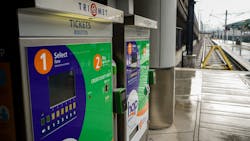TriMet to consolidate ticket machines to boost efficiency, encourage more riders to enjoy the benefits of Hop
TriMet will soon scale back the ticket vending machines at its MAX light rail and WES commuter rail systems as part of its efforts to meet rider trends, improve efficiency and promote Hop Fastpass™ as a better way to pay.
Starting on June 15, TriMet will begin reducing the number of ticket machines by 65, focusing on redundant machines across the system, a project that’s expected to take about two months to complete.
A better way to pay
Hop is the better way to pay, allowing riders to tap, board and save, all at the same time. Hop means never overpaying thanks to fare capping, which rewards riders with free rides once they meet the equivalent of a daily or monthly pass.
Hop’s convenience is its main advantage. Riders have a choice between a plastic Hop card or a virtual Hop card stored in their smartphone. Either tap the card itself at the Hop reader or do the same with a smartphone if there’s a bankcard stored in the mobile wallet. Bankcards don’t have the monthly fare-capping and other benefits of Hop cards but can be convenient for those who don’t ride often. Hop readers are located on rail platforms and inside buses and the Portland Streetcar.
Ticket machine locations maintained for equity, safety
While Hop is still the easiest and most cost-effective way to pay fare, TriMet says it knows some riders continue to rely on the ticket machines. This is why riders will still be able to find at least one near every MAX station or transit center. At stations where trains going in separate directions stop, TriMet will keep a ticket machine on both sides of the tracks so riders can pay without needing to cross the tracks. At some of the busiest stations, such as the Rose Quarter Transit Center, all the machines will stay in place to help keep riders moving.
Although some ticket machines that accept both cash and cards will be removed, TriMet says it is going to keep most of them installed as it prioritizes the removal of card-only machines. TriMet adds it strives to make the system as flexible and easy to use as possible, with fare options that give riders equal access to buses and trains. TriMet has also prioritized keeping machines with the cash option in low-income areas and locations with fewer retailers that support TriMet’s Hop Fastpass.
Saving money, increasing efficiency
Consolidating the number of machines will save TriMet about $5.5 million in capital expenses. The move will also save the agency $35,000 a year on the purchase of parts and 1,500 hours of labor time, which will be shifted to support other technologies across the system.
Overall, TriMet will decrease the number of ticket vending machines from 234 to 169, a drop of 28 percent. The agency says it is prioritizing the removal of machines that are less used or are located close to other machines.
More payment options, more opportunities
Since the introduction of Hop in 2017, TriMet says it has seen major changes in the ways riders pay. Use of ticket machines hit a high in 2014 before dropping more than 43 percent by 2019 as the electronic fare payment option became available.
Currently, about 19 percent of fares are paid using Hop, while another four percent come from payments made from contactless debit/credit cards on smartphones. While both of these figures have increased since 2019—by seven and three percent respectively—fares paid via ticket vending machine have dropped from 11 to 9 percent over the same period.
Increased enrollment in TriMet’s Low Income Fare program has also helped shift more riders to Hop. Once enrolled, participants gain unlimited access to public transportation services from TriMet, C-TRAN and Portland Streetcar, all at the Honored Citizen rate of $1.25 for 2.5 hours and $2.50 for a day pass. That comes to $28 a month or $336 a year.



